The best material for your project depends on your budget and your 3D printer, but mostly, on what characteristics you want your final part to have: tough, durable, flexible, clear, heat resistant, or a combination of these and other attributes.
Because, in the long run, materials will make up the bulk of your 3D printing investment, it pays to understand their properties and how to print with them, which can vary dramatically.
Here at All3DP, we have hundreds of guides to 3D printing materials, from the best carbon-fiber-infused filaments to the best bed and print temperature settings for TPU. We print every day in various materials. Whether you’re a home hobbyist just getting started or a seasoned engineer looking to build a better industrial component, we’ve got you covered.
From functional models like tools or prosthetics to fun objects like games or figurines, there’s a filament out there that’s best suited to the task at hand. In this guide, we will take a look at the top 20 types of filament materials, including their special attributes, to help you select the best material for your next project.
Filament
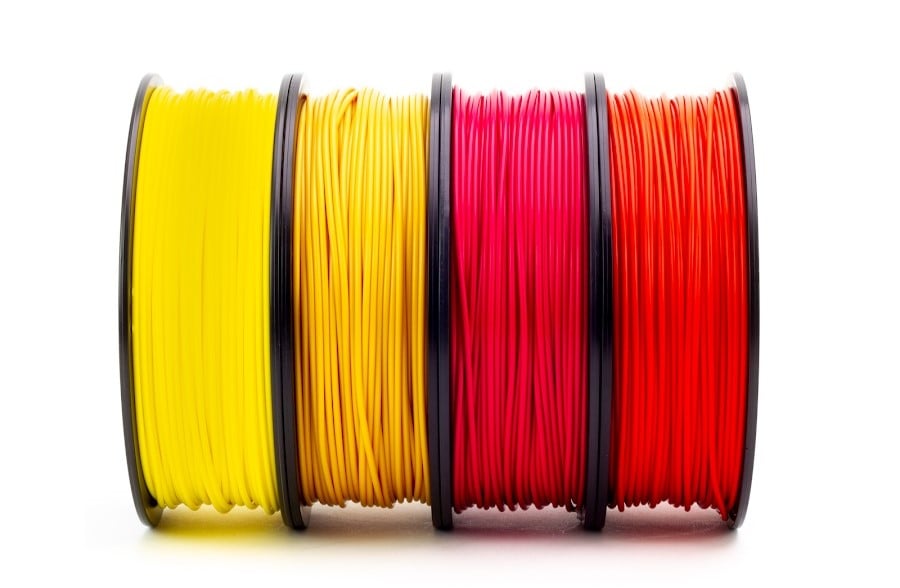
The most popular way to 3D print is with a fused deposition modeling (FDM) printer, which has traditionally been the easiest and cheapest way to 3D print. This type of 3D printer uses material in filament form, which is a spool of a plastic cord. Some FDMs today can also use plastic in a more economical pellet form.
The most common filament is the thermoplastics PLA, but there are so many more out there. Here are just a handful of properties you may want in your 3D printed part that you won’t find in PLA.
- Impact resistance
- Durability
- Crack resistance
- Chemical & solvent resistance
- Weatherability
- Flame retardant
- Electrostatic dampening
- UV resistant
- Biocompatible
- Recycled
- Sustainable
- Food safe
For a deeper dive into even more filament types, check out the guide linked below.

PLA: All-Rounder
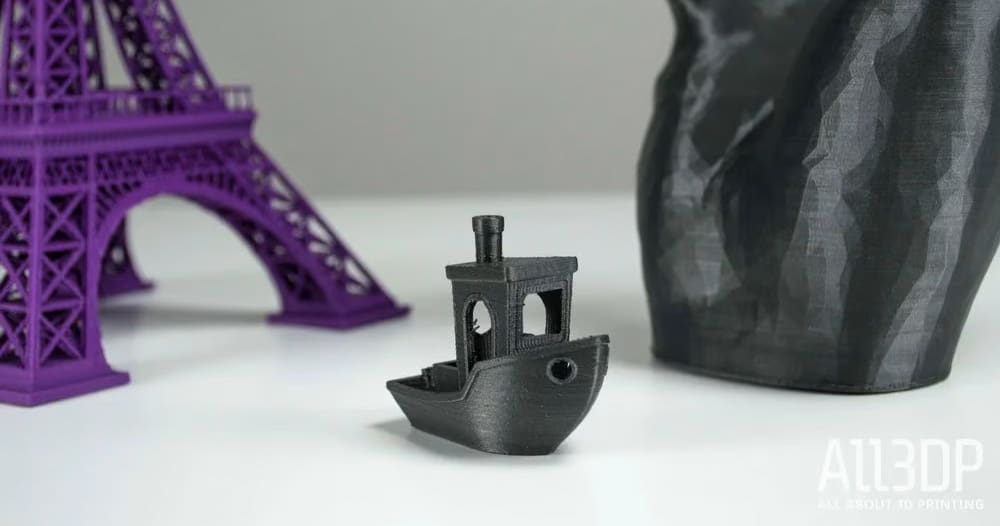
A crowd favorite and the material most hobbyists start with is PLA. It’s affordable, easy to print with, and practically universally compatible with FDM printers. PLA is short for polylactic acid, a thermoplastic polymer derived from renewable resources, specifically corn starch or sugar cane. It can be recycled at industrial facilities but is not biodegradable.
It has a low printing temperature, doesn’t need a heated bed (although it helps), and doesn’t warp as easily as other materials, so it’s great for beginners. Another benefit of using PLA is that it doesn’t produce much of an off-putting odor during printing. It is a suitable 3D printing material for single-use food contact.
However, PLA is less durable than ABS or PETG and is susceptible to heat. Avoid using it when making items that might be bent, twisted, or repeatedly dropped, such as phone cases, high-wear toys, or tool handles. And don’t use it for items that will be near heat or left out in the sun.
Although PLA is a type of plastic, most filaments will have additives. The cheaper brands, in our experience, will have more additives and their print quality is not as predictable as the more prominent brands, so of course, you get what you pay for.
PLA is available in a broad range of colors and features, like these:
- Silk-like PLA
- Recycled PLA
- Glitter, Sparkly PLA
- Lightweight & Foam PLA
- Color Changing PLA
- Wood PLA
- Biodegradable PLA
- Carbon Fiber PLA
- Glow-in-the-Dark PLA
- Conductive PLA
- Translucent PLA
- Metal PLA
Most Common Applications:
Prototypes and parts that don’t require a substantial amount of strength. Parts that will not be exposed to heat.
ABS: Rock-Hard
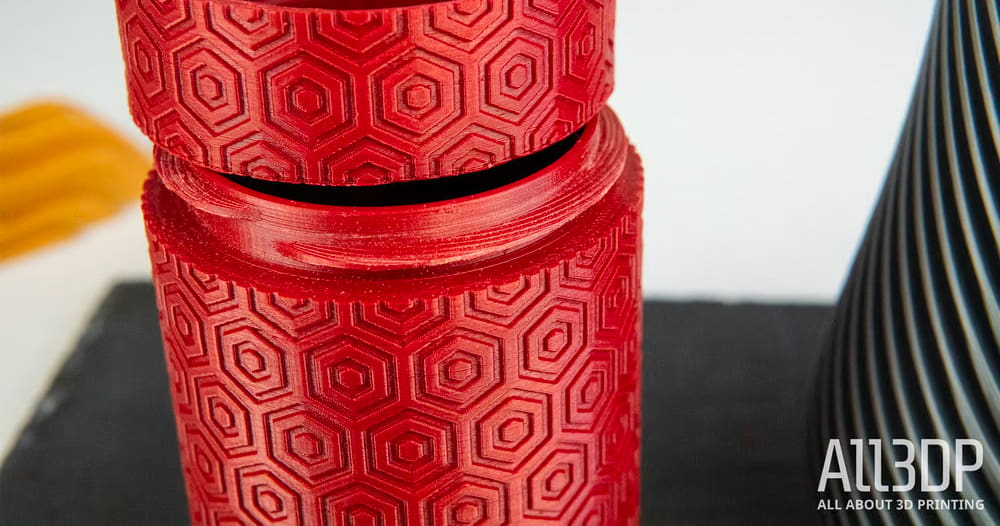
Remember the quality of Lego bricks? Then you can relate to why ABS (acrylonitrile butadiene styrene) is one of the most popular 3D printing materials to date. Made from petroleum, ABS is commonly used in injection molding and is found in many household items, such as those rock-hard Lego bricks, phone cases, or bicycle helmets – due to its durability, robustness, and temperature resistance. If you want to avoid petroleum-based products, which we recommend, take a look at a PLA composite, like tough-PLA or carbon-fiber infused PLA.
Although it plays a major role in commercial applications, such as rapid prototyping, in hobbyist 3D printing, ABS is less popular. This is due to it being slightly more difficult to print – it’s prone to warping without an enclosed and heated build chamber.
ABS is used high-wear toys, tool handles, automotive trim components, and electrical enclosures. It is readily affordable, strong, lightweight, allows for easy post-processing, and comes in a broad range of colors. However, ABS releases smelly and toxic chemicals during printing. Address this by printing in a well-ventilated area and/or with an enclosure. Not being in the room while printing is also recommended.
For all of its advantages ABS isn’t recommended for outdoor applications and does not have good resistance to chemicals. It scratches easily and, unless flame retardant additives are included, ABS parts can burn easily.
ABS Printing Tips:
Most Common Applications:
Tools, phone mounts, cup holders, functional prototypes
PETG: Food-Safe
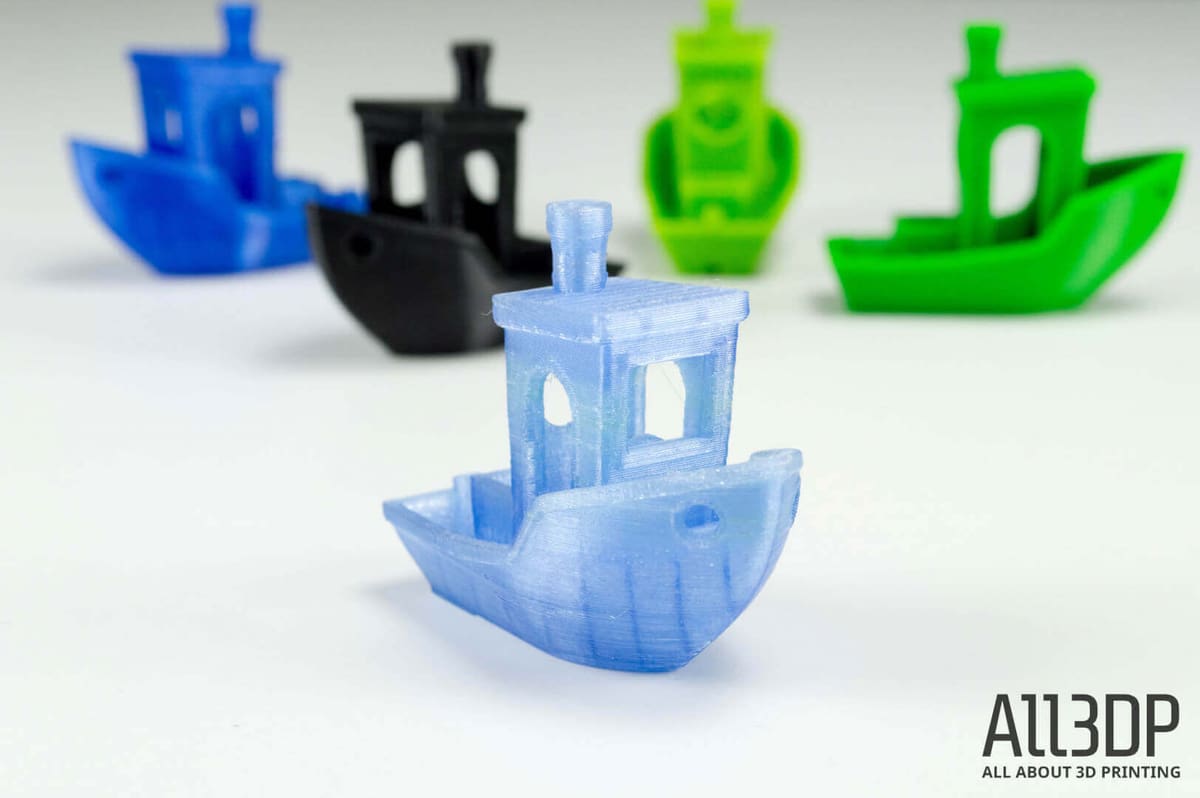
PETG is made from polyethylene terephthalate (PET), the material you know from plastic water bottles, but some ethylene glycol is replaced with CHDM (cyclohexanedimethanol) — hence the letter “G” after PET for “glycol-modified”. The result is a filament that is clearer, less brittle, and easier to use than its base form of PET.
It’s an excellent filament choice for printing objects that need to be sturdy, have a smooth surface, and have lower shrinkage. PETG components are weather-resistant and are thus often used for garden appliances. It’s resistant to salts and acids so, applicable for pool toys. It’s also popular because PETG is considered food-safe — but you should still read the fine print on any spool you buy to be sure.
Of course, it’s not all good news: PETG can be difficult to print with. It isn’t great at bridging because it’s rather sticky, but this does mean it has great layer adhesion. It’s also more hygroscopic (absorbs airborne moisture) than PLA, so it is prone to both heavy stringing if not properly dried or stored. But, if you need a good all-around, high-strength material that is less complicated to print than ABS, PETG is a great option.
There are more variations of PET in filament than just the familiar glycol-added version. You’ll find recycled PETG and some carbon-fiber-infused PETG to give it extra strength.
PETG Printing Tips:
Most Common Applications:
Packing prototypes, displays, signage, containers that need to be more durable than PLA
TPU, TPE, TPC: Flexible
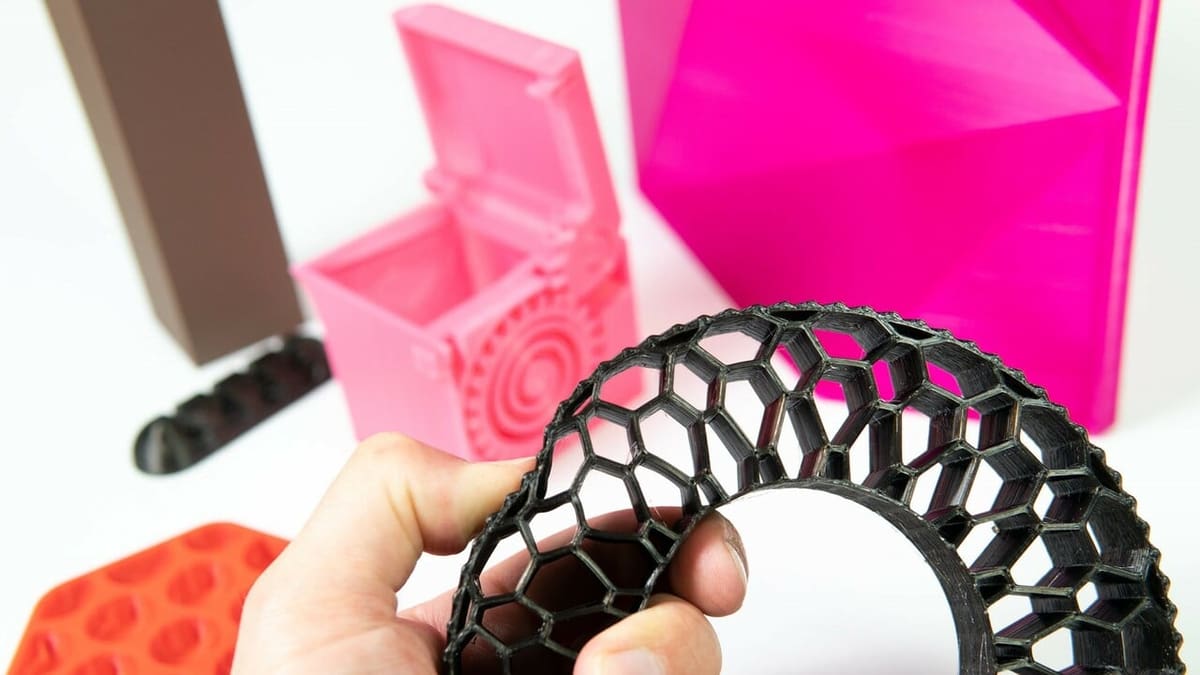
TPEs (thermoplastic elastomers) are a class of materials that are a blend of plastic and rubber and include TPU (thermoplastic polyurethane), TPC (thermoplastic co-polyester), and others.
These plastics are very soft and flexible. They are becoming more common in additive manufacturing to produce parts that can be bent or stretched without any deformation.
TPUs (the most popular of the flexibles) are also generally more durable and can offer higher resistance to abrasion, oils, chemicals, and high and low temperatures than TPE filaments. TPC boasts high-temperature resistance and excellent UV resistance. It is especially prized in biomedical applications and for wearable and medical devices.
Flexibles are not that easy to print, requiring good control of the printing process. Pre-drying the filament, as well as proper bed heating, nozzle temperatures, and print speeds, will up your chances of success with this versatile material.
Additives can improve the features of flexibles. You’ll find variations with added flame retardancy and extra weather resistance. TPU can be mixed with glass fibers for added dimensional stability and better impact strength.
TPU Printing Tips:
Most Common Applications:
Toy wheels, handles, sports equipment, automotive components, hoses
Nylon: Tough & Durable
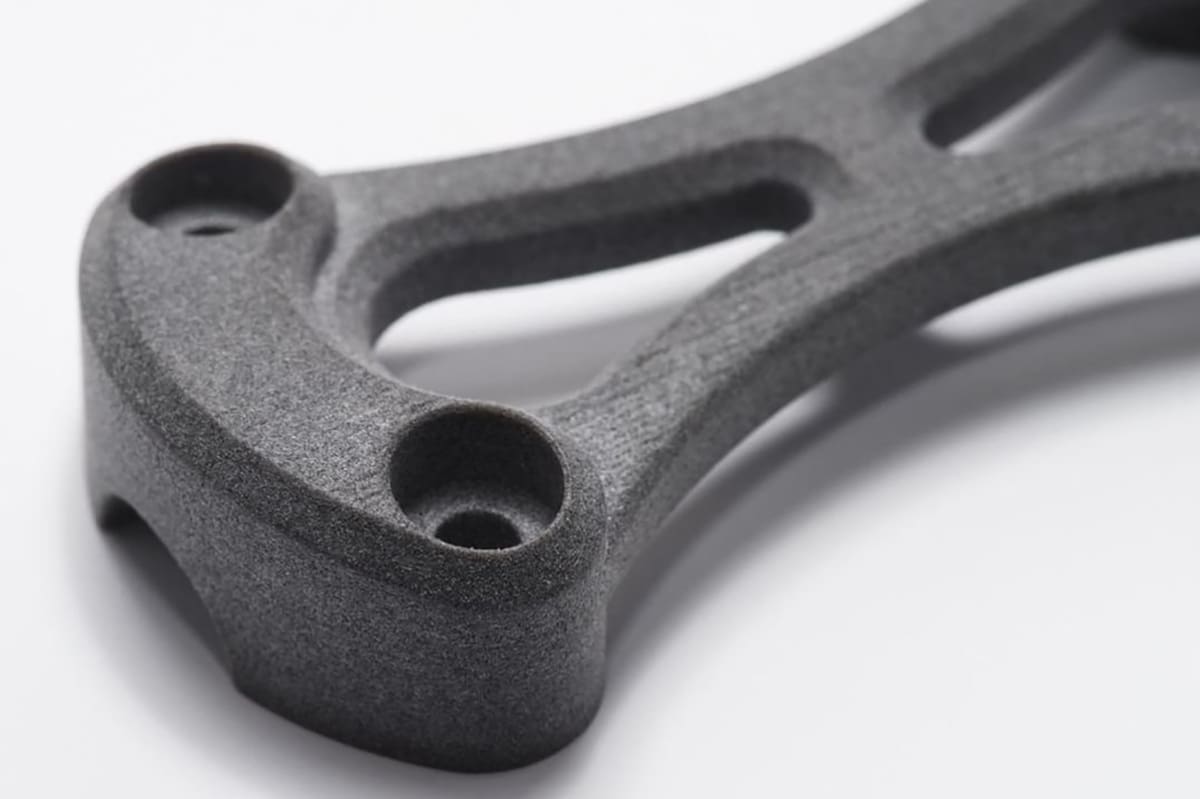
Polyamide (PA), commonly known as nylon, is a tough and durable material used for a wide range of applications, such as manufacturing aids, drone parts, and housings. The material stands out for its resistance to impact, wear, and high temperatures. It offers good tensile and mechanical strength.
Because manufacturers have been making products out of nylon for nearly 100 years, it’s a familiar material to 3D print with. All of nylon’s well-known characteristics are available when you 3D print with it.
Nylon isn’t just one material; it’s a category. In 3D printing, you’ll find PA6, PA11, and PA12, yet you may need to read the spec sheet to see which PA your nylon filament actually is. PA11 is a bio-based plastic derived from renewable resources like castor plants, whereas PA12 can be bio-based or a synthetic polymer derived from fossil fuels. Both PA11 and PA12 have excellent chemical resistance, durability, cold impact resistance, and thermal resistance.
PA is commonly reinforced with carbon, glass, and kevlar fibers, or embedded with continuous carbon fiber, for added reinforcement. Widely used in high-end engineering applications, such as gears, jigs and fixtures.
Although you shouldn’t expect it to print as easily as PLA or PETG, printability shouldn’t be a deal-breaker, but you may need a high-temperature nozzle, as some blends will need up to 300°C to be processed. Proper storage for nylon is also critical since it can soak up water when left out in the open. This moisture degrades the material and yields poor print quality and strength.
Most Common Applications:
Jigs & fixtures, manufacturing tools, drone parts, housings & casings for electronics
ASA: Sunlight Resistant
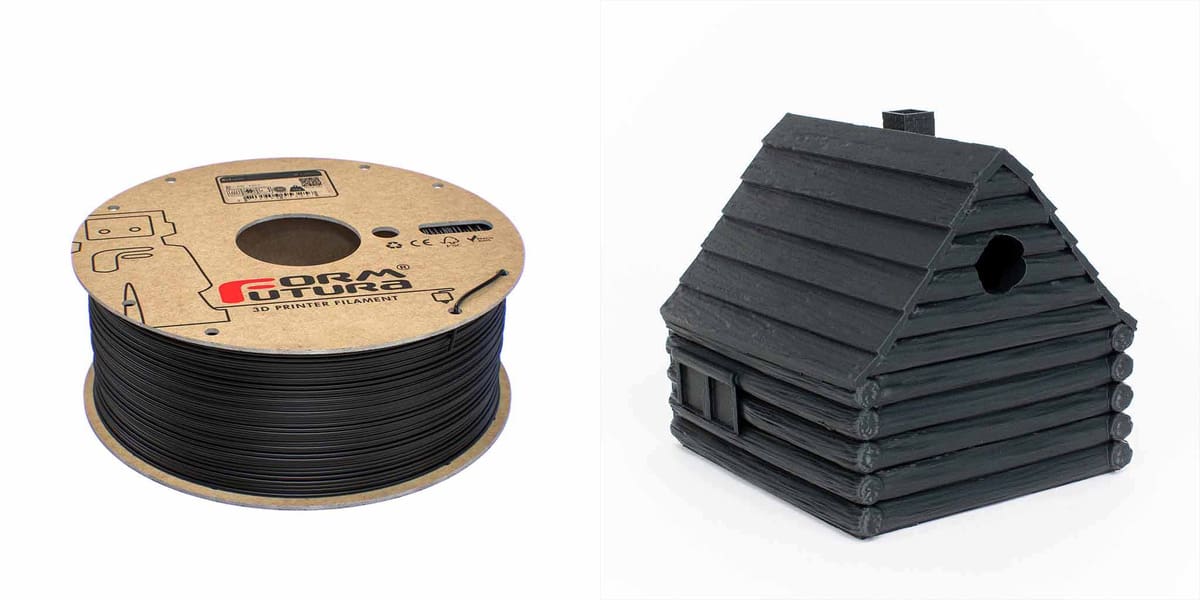
This tongue twister of a material called acrylonitrile styrene acrylate is known for high impact strength and chemical resistance, yet is was basically created for one purpose: outdoor use. It has high UV resistance, rigidity, high heat resistance, and high chemical resistance. Colored ASA resists fading outside.
It’s the easier-to-print cousin of ABS, but also requires high extruder and bed temperatures and an enclosure to counteract warping, cracking, and shrinking. It is certainly not for every printer, but it can be handled by more capable desktop machines and, naturally, industrial FDMs.
ASA Printing Tips:
Most Common Applications:
Parts constantly exposed to outdoor elements, bird houses, outdoor light fixtures, garden decoration
PVB: Smooth & Clear
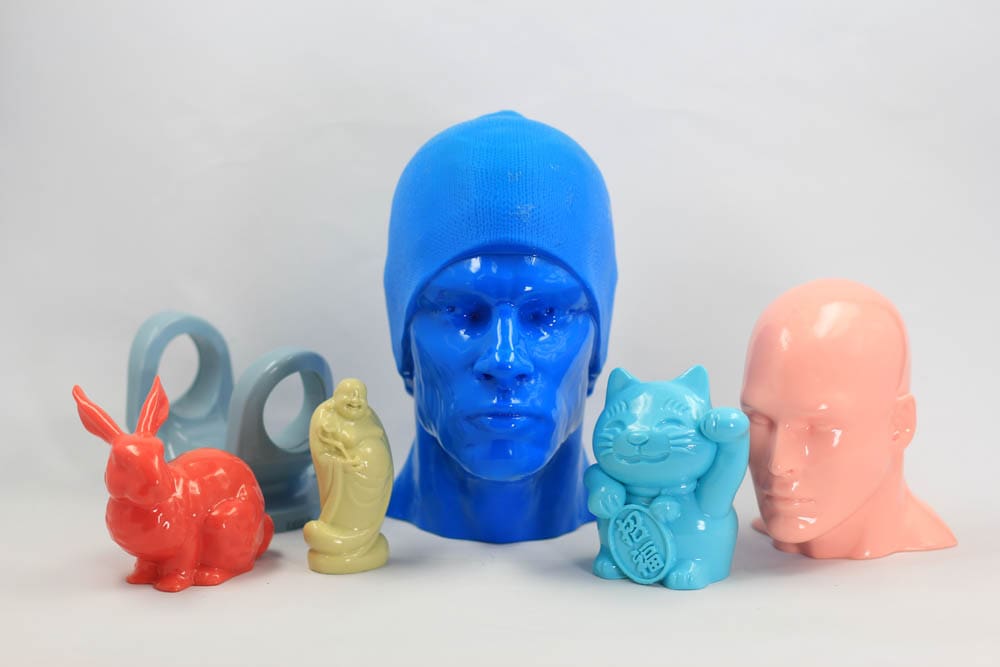
PVB, short for polyvinyl butyral, is a specialty filament that is most known for its ability to be layer smoothed with isopropyl alcohol. This makes it a safer alternative to ABS, which needs acetone for layer smoothing. Polymaker, for example, offers a variety of PVB filament colors to be processed in its Polysher machine, an alcohol mister, for even results. Plus, PVB is a transparent material, so translucent and clear prints are also achievable.
PVB has similar material properties to PLA, only with the exception that it has poor layer adhesion and, therefore, inferior mechanical properties, which is definitely a drawback. It also has relatively higher hygroscopic properties, so make sure to keep your filament dry. If you want to print smooth models for the purpose of placing them on a shelf to impress visitors, it could be worth looking into PVB.
Most Common Applications:
Art, aesthetic prints, product prototypes
HIPS: High-Impact
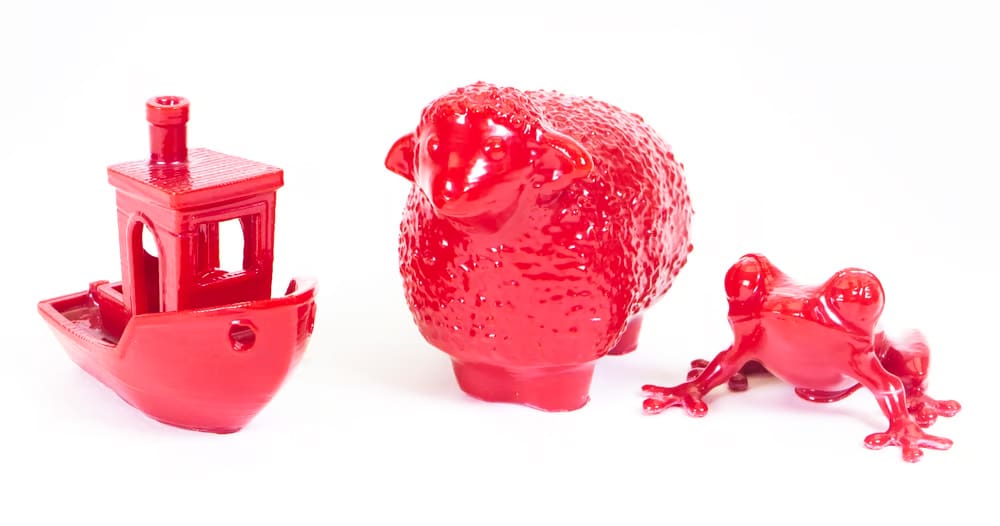
High-impact polystyrene (HIPS) is a material blend of polystyrene plastic and polybutadiene rubber. The mixture of these polymers results in a material that’s both tough and flexible, although not as flexible as TPU.
HIPS is very similar to ABS, but as the name implies, it can withstand much higher impact forces. It’s easily painted, sanded, and machined and works with a large number of adhesives. This makes it popular among architects for scale models. Moreover, it’s food-safe and has been declared FDA-compliant for food processing applications (although always read the label on the specific brand of HIPS that you buy).
Within the 3D printing world, HIPS is mostly used as support material since it dissolves in limonene solution, eliminating the need for removal via abrasives, cutting tools, or any other such things that leave your print less than perfect. This characteristic can also be used to smooth HIPS and obtain shiny surfaces, something that’s very hard to achieve with PLA. Limonene is a solution made with lemon peels and it can be easily obtained. This solution, however, can potentially damage 3D printing materials other than ABS.
Most Common Applications:
Dissolvable supports for 3D printed parts, architectural models, scale models
PVA: Water Soluble
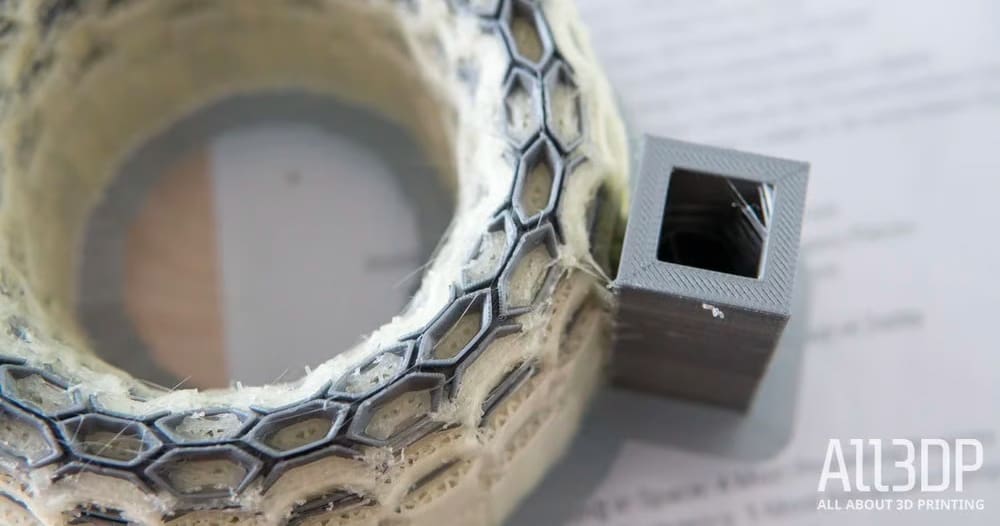
Polyvinyl alcohol (PVA) is soluble in water, and that’s exactly what commercial applications take advantage of. For 3D printing, PVA, like HIPS, is engineered for use as a soluble support material, primarily when paired with another 3D printer filament in a dual extrusion 3D printer. The advantage of using PVA over HIPS is that it can support more materials than just ABS. For example, Ultimaker PVA has excellent adhesion to both PLA and nylon. Other PVAs may be formulated as soluble companions to other polymers.
There are more soluble materials than PVA and HIPS in the engineering category of filaments. One example is Infinite Material Solutions’ AquaSys GP, which the company says will dissolve better without remnants in the internal channels of complex parts.
The trade-off is a 3D printer filament that is slightly more difficult to handle. One must also be careful when storing it, as the moisture in the atmosphere can damage the filament before printing. Dry boxes and silica pouches are a must if you plan to keep a spool of PVA usable in the long run.
Most Common Applications:
3D printing support material
Conductive & EDS Safe
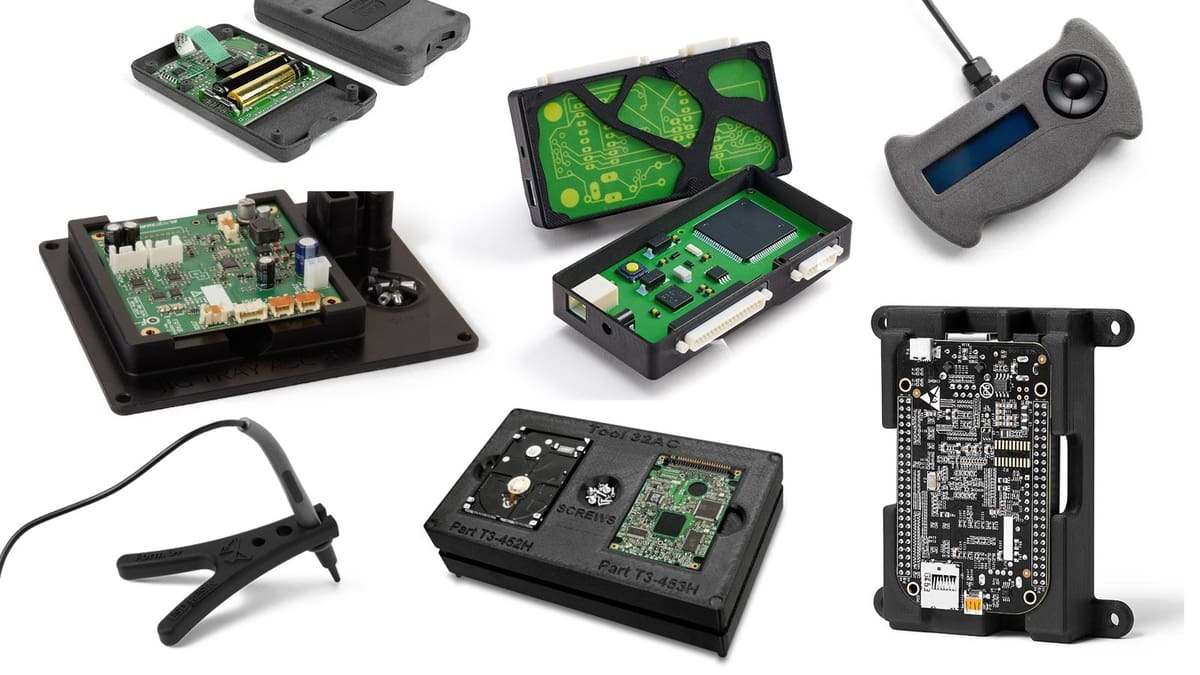
Conductive 3D printer filament does as its name implies: conduct electricity, whereas most plastics are electric insulators. With the addition of conductive carbon particulates, mostly graphene, to base materials, such as PLA or nylon, these materials can dissipate electrical charges before they can damage electric components.
If you want to protect your electronics from electric discharge, then you’ll need an EDS-safe material. 3D printing with electrostatic discharge-safe filament for your housings, fixtures, and tools can protect them. With these materials, you can print circuit board housings, tools and fixtures used in electronics testing, and more parts and products that will protect your electronics from electrical charges.
Material manufacturers should list their materials’ surface resistance rating range in ohms and may have ISO or other certifications for industries that require a material ESD-safe certified or approved for use in clean electronics manufacturing environments.
The material characteristics of your part, other than ESD-safe, will be those of the base material.
Most Common Applications:
Circuit board housings, tools and fixtures used in electronics testing
Wood Composite

Wood 3D filament is actually a composite of a polymer and a wood fiber. There are many wood-PLA 3D printer filaments available today. Wood is added to polymer filaments to provide a wood-like (to varying degrees) look to the final parts. Note that wood filament varieties, such as pine, birch, and ebony, typically refer to the color, not the type of wood that’s in the filament.
As with other types of 3D printer filament, there is a trade-off with using wood. In this case, the aesthetic and tactile appeal come at the cost of reduced flexibility and strength. Typically, additives add to the strength of a polymer, but in the case of wood, it’s the opposite. Wood-filled filament can also accelerate the degradation of your 3D printer’s nozzle, so keep that in mind before using this material.
Be careful with the temperature at which you print wood, as too much heat can result in an almost burnt or caramelized appearance. On the other hand, the base appearance of your wooden creations can be greatly improved with a little post-print processing. You can cut it, sand it, or stain it.
Most Common Applications:
Decorative applications that will not require strength
Metallic Appearance
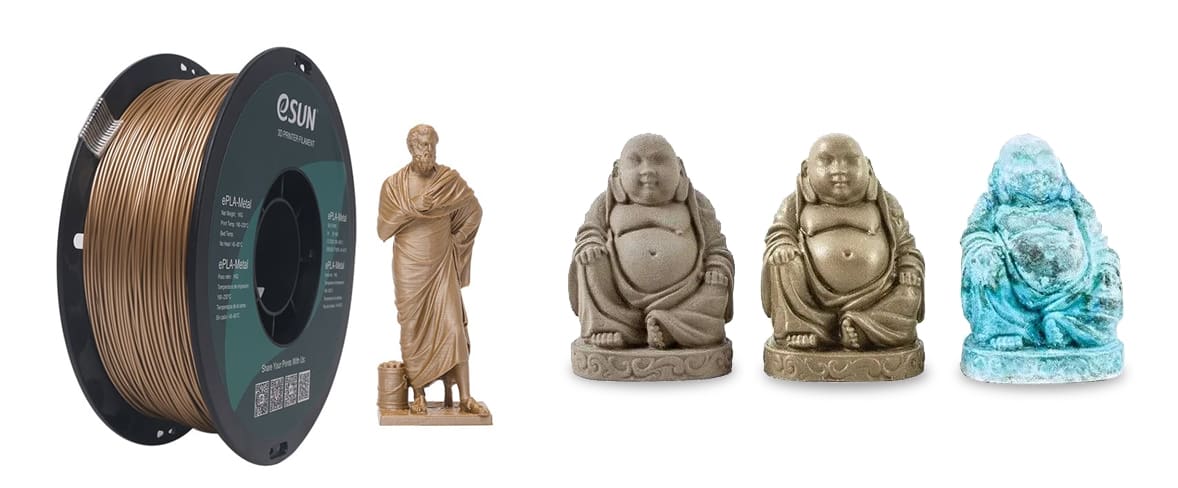
For the look of metal, polymer filament is infused with just enough metal powder to look like metal when the final part is polished. Even the weight is metal-like because these blends tend to be several times denser than pure plastic filament, making this material great for 3D printing trophies and figurines. Keep in mind that it won’t have the actual functionality of metal.
This metal filament usually contains between 10% and 30% real metal, such as bronze or copper, embedded into PLA, and is often called metal composite material. It produces prints that can easily pass for metal (visually), but don’t confuse this material with the metal/polymer composites next on our list that produce real metal parts.
When printing with these metallic composites, expect increased nozzle wear. Therefore, it is recommended to switch your brass nozzle to stainless steel or another hardened alloy since brass nozzles wear out much faster from metal particle abrasion.
If you’re just looking for the shine of metal, silk-like PLA filaments in gold, bronze, and silver color, are also a good option.
Most Common Applications:
Trophies, figurines, models, chess pieces
Real Metal
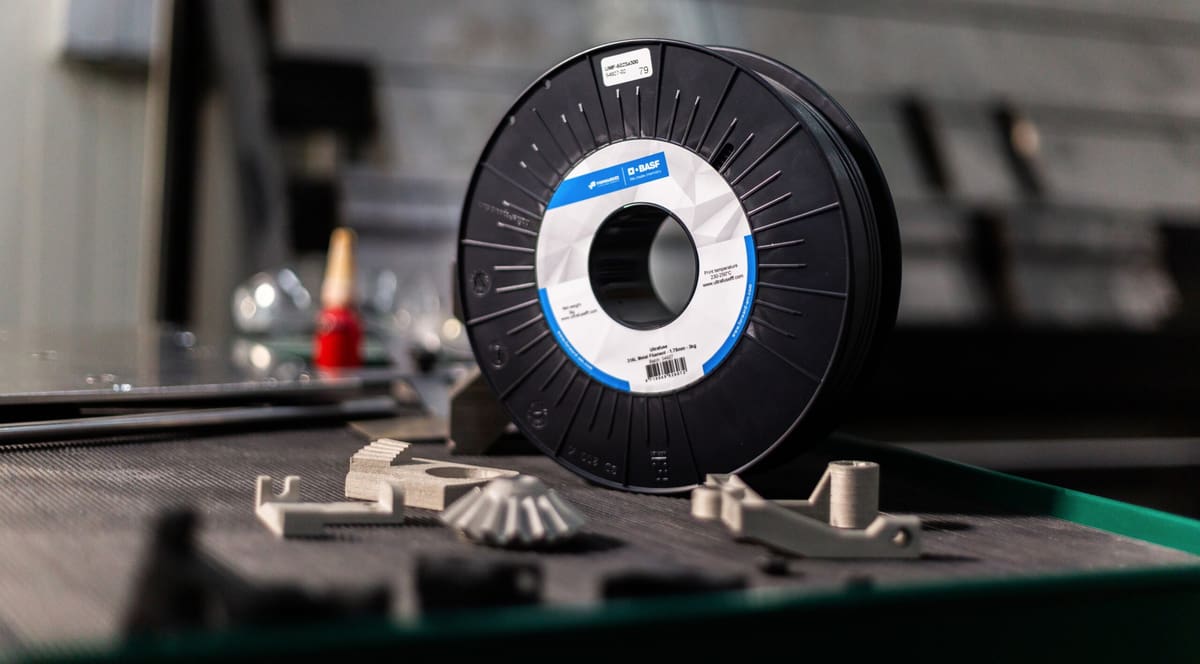
Introduced a few years ago and now skyrocketing in popularity, metal filament is used to create real, solid metal parts. Consumers and professionals are turning to this material to produce everything from figurines to small replacement parts and tools. The benefit is tremendous cost and time savings over machining or molding metal.
Several FDM 3D printer makers, including UltiMaker, BCN3D, and Anycubic have launched printer profiles that enable you to print with metal filament on their machines. Metal filaments for metal parts are only available from a small handful of producers, including BASF and The Virtual Foundry.
These filaments contain a high percentage of metal powder (around 80%), but they do not produce metal parts right off the print bed; they must go through two post-processing stages that melt away the plastic and then condense the metal part. For a deep dive into printing real metal parts with metal filament, see the guide linked below.
A key benefit of metal filament is how easy it is to print with on a regular 3D printer. Just note that, by “regular”, we mean any FDM printer with a heated bed and a hardened steel nozzle that can reach the required temperatures of at least 180ºC to 220ºC. In theory, this means that you don’t need an expensive machine; you can print it on machines under $200, like an Ender 3 or Anet A8. However the material itself is pricy and you also have to pay for the post-processing.
Available metals:
Most Common Applications:
Spare parts, machine parts, gears, impellers
PC: Heat Resistant
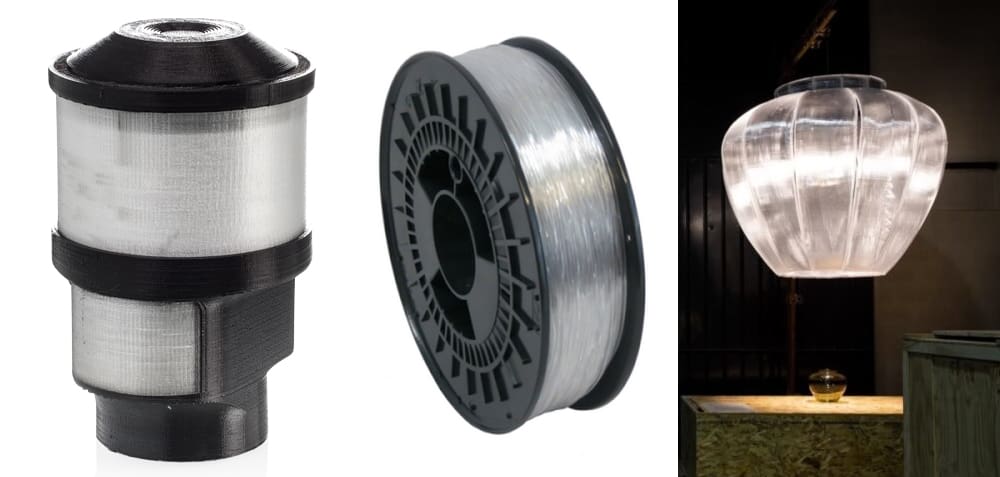
Polycarbonate (PC) is a strong material that stands out for three main features: optical clarity, resistance to heat, and incredible toughness. When 3D printed, it’s used across industries for automotive headlight prototypes, lamp shades, and translucent cases for electrical components.
PC is a renowned replacement for glass since it’s clear, 250 times more impact-resistant than glass, and can be drilled without any problem of cracking. It can take on colors and remain translucent or completely opaque. It’s also mixed with other plastics to boost impact resistance. For example, PC-ABS, which comes in black and white, is used for products, such as drone bodies and replacement parts that need more strength than ABS alone. You’ll also find PC with additives, including carbon fibers.
Parts 3D printed in PC exhibit high toughness in cold temperatures (down to -20 °C) so this material is good for outside use. It’s intrinsically flame retardant, and has good electrical insulation properties not influenced by water or temperature. It can also withstand repeated steam sterilizations, so it’s used in some healthcare applications.
PC is often found in polymer blends, such as PC-ABS.
Most Common Applications:
Lighting fixtures, electrical and electronic equipment
PEI: High Strength-to-Weight Ratio
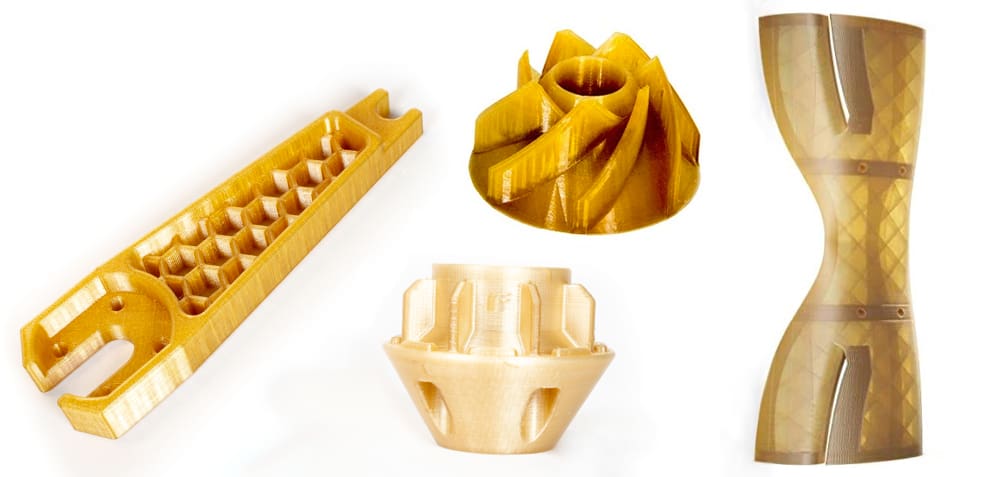
Polyetherimide (PEI) was first developed in 1982 by General Electric Company (now known as SABIC) under the trade name Ultem, as it is still commonly known. This high-performance plastic is characterized by outstanding thermal, mechanical, and electrical properties, and most used as a cost-effective alternative to metal. It can retail for more than $350 per kilo, so it’s strictly an engineering-grade material.
PEI offers manufacturers a high strength-to-weight ratio, making it strong enough to replace steel in some applications and light enough to be used in others to replace aluminum, particularly in aerospace.
There are many grades of Ultem, the most common being Ultem 1000. Ultem 1010 is a resin material, and Ultem 2300 is a 30% glass-reinforced. You’ll find PEI variations with carbon fiber.
PEI also has good UV-light resistance and weatherability and is inherently flame resistant. It’s also resistant to alcohols, acids, and hydrocarbon solvents but dissolves in partially halogenated solvents. Most PEI grades are food-contact compliant.
Most Common Applications:
Gear components, valve housings, sensor and thermostat housings, automotive, aerospace
PEEK: Lightweight Metal Replacement
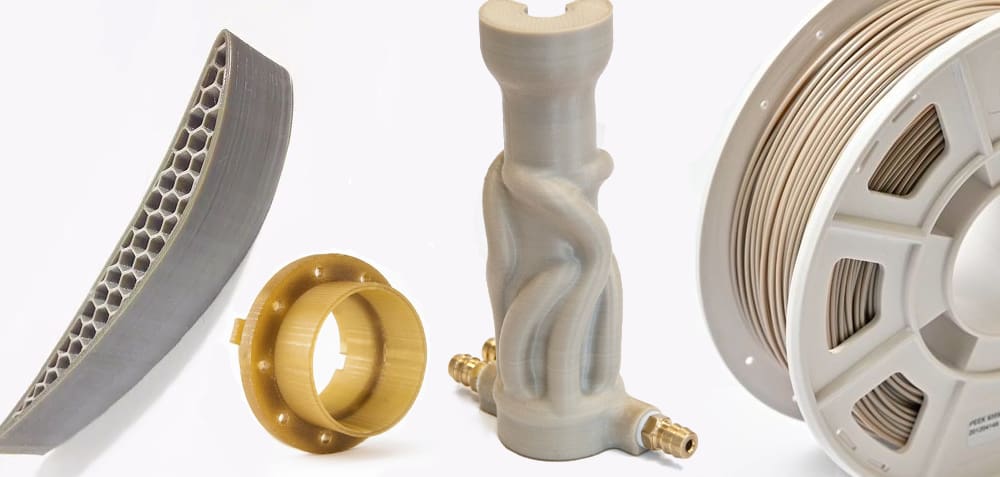
PEEK belongs to the Polyaryletherketone (PAEK) family of polymers and is enjoying growing popularity for applications in the military, pharma, petrochemicals, healthcare, and food packing.
Its high cost, however, and tricky processing limit it to industrial use with specific printers. PEEK has less than half the weight of aluminum and one-sixth that of steel, making it an excellent metal replacement for parts in the oil and gas industry and in aerospace. PEEK’s properties can be further enhanced by combining it with composite materials, such as glass fiber, graphite, or carbon reinforcements, which help fight shrinkage.
PEEK is also used for medical implants (since it is fully biocompatibility and Xray transparent), but there’s a huge difference between industrial and implantable PEEK, with Evonik offering the only fully medically approved PEEK filament on the market to date (priced around $5,000/kg).
PEEK is highly resistant to extreme temperatures up to 260°C and corrosive fluids, gases, and high pressures. It can be sterilized repeatedly and maintain its dimensional stability.
Most Common Applications:
Components in aerospace, automotive, and health care. Bone replacement implants in humans.
PEKK: Stiff & Strong
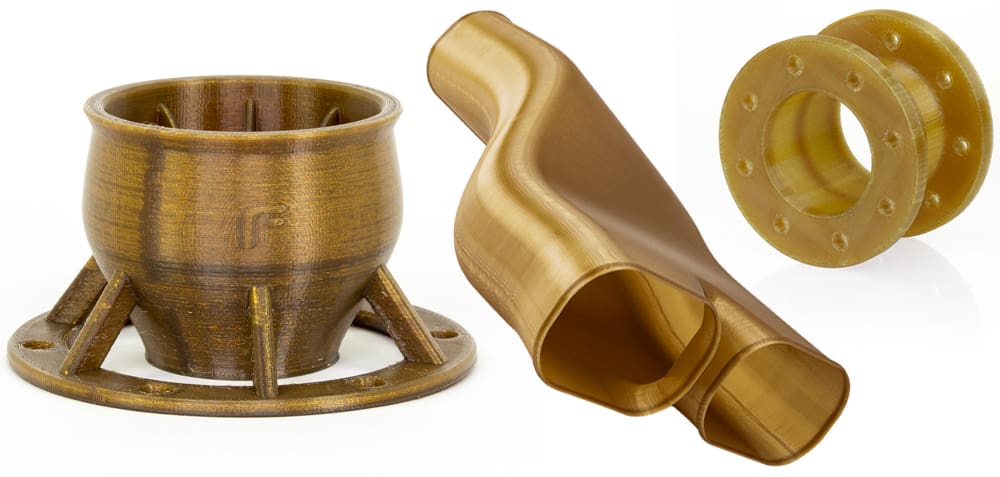
PEKK is another polymer in the Polyaryletherketone (PEAK) family and has exceptionally good mechanical, thermal, and chemical resistance properties. One reason some additive manufacturers select PEKK over PEEK is that it’s generally easier to print with.
PEKK can be processed at lower 3D printing temperatures than PEEK-based filaments, doesn’t require a super-heated chamber (like PEEK), and has excellent layer bonding, resulting in parts with exceptional dimensional accuracy and z-strength. This is another versatile high-performance 3D printing polymer that can replace metal and composite parts in various industries from aerospace and automotive to medtech and marine. The material is resistant to virtually all organic and inorganic chemicals.
Parts printed with PEKK may be heat treated (annealed) after printing to maximize the mechanical, thermal, and chemical resistance properties. Printed parts will be translucent golden in color and then turn an opaque tan color once annealed.
Most Common Applications:
Components in aerospace, automotive, oil & gas
PVDF: Resists Extreme Conditions
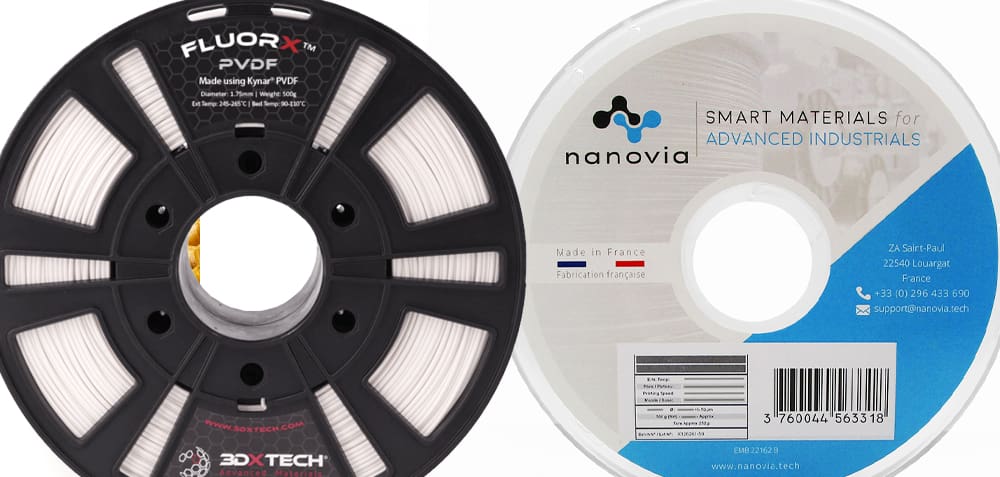
PVDF (polyvinylidenefluoride) is another polymer that is gaining applications in additive manufacturing due to its unique set of properties. PVDF is widely used in high-tech applications, such as chemical process equipment, semiconductors, lithium-ion batteries, and other electrical, electronic, and energy-related applications.
It has high stability when exposed to harsh thermal, chemical and radiation environments, so it’s a top choice for parts and components that will be launched into space or installed in the oil & gas industry. Panels made of PVDF are used on space probes and satellites. It has high abrasion resistance, excellent aging resistance, and low permeability to most gases and liquids.
Not a filament you’ll find listed along with the PLA online, so reach out to material experts like Syensqo, a PVDF maker for application guidance.
Most Common Applications:
Industrial application in space, oil & gas, manufacturing
PPSU: Transparent at Super High Heat
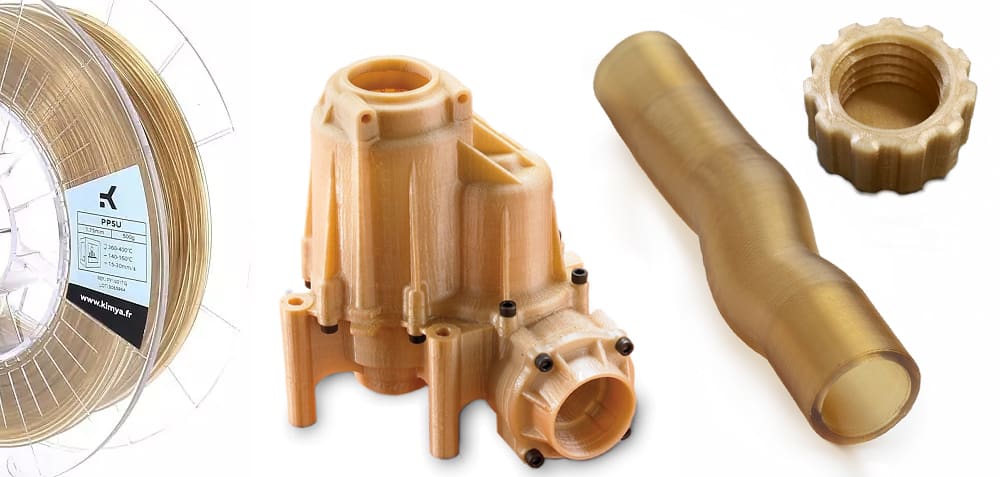
Sulfone polymers (PPSU, PESU, PSU) are another family of high-performance plastics that combine excellent thermal stability, high strength and toughness, excellent hydrolytic stability, transparency, and good resistance to environmental stress cracking. These are generally a bit more economical than PEAK polymers and relatively easy to 3D print with.
Setting these apart from the PEAK family is their high heat deflection temperatures (similar to PEI) and they are the only thermoplastics that remain transparent at super high temperatures (204 ºC), even after long-term exposure. PPSUs deliver long-lasting performance in hot water and steam, even under pressure, so they are often used to replace brass in pressurized hot water applications. They can be used as a lightweight alternative to metal in surgical sterilization cases and trays, implant trials, surgical instrument handles, and a host of other medical and dental devices. PPSU is also widely used in food service applications and aircraft cabin interiors.
Most Common Applications:
Aerospace cabin interior, powertrain (contact to engine oils) components, medical devices applications requiring steam sterilization
Biocompatible Filaments

Many polymers, such as PLA, PEEK, and nylon are biocompatible by nature, but that does not mean that all PLA, PEEK, and nylon 3D printing filaments are biocompatible. There are often additives in the polymer filaments to make them perform better during 3D printing or colorants. So to make biocompatible products, you need to start with a certified biocompatible filament, which only comes from a few makers, including Solvay, Evonik, DSM, and Stratasys.
If you’re more interested in a material that won’t cause skin irritation or something that best for a child’s toy that could make it way into a mouth for a few minutes, check out our guide to biocompatible materials linked below.
For medical professionals, like a dentist, you’ll need to consider the FDA ratings of your materials and how a polymer stands up to sterilization and various chemical disinfectants. Some cleaning chemicals used on polymers can start to break down the material. Most manufacturers of biocompatible filaments will detail in the technical specifications whether parts 3D printed with their material, can stand up to specific chemical exposure and sterilization methods.
Rather than filament, 3D printing resin is the material of choice for dental professionals. We cover the most common types in this guide below.
Most Common Applications:
Implants, surgical guides, medical tools, orthopedic braces
License: The text of "Top 20 Most Popular 3D Printing Filament Types Compared" by All3DP Pro is licensed under a Creative Commons Attribution 4.0 International License.

























